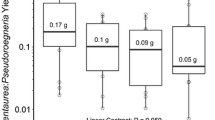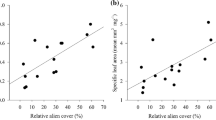Abstract
The relationship between diversity and productivity of plant community under plant invasion has been not well known up to now. Here, we investigated the relationship between diversity and productivity under plant invasion and studied the response of species level plant mass to species richness in native and invaded communities. A field experiment from 2008 to 2013 and a pot experiment in 2014 were conducted to study the effects of plant invasion on the relationship between diversity and productivity and the response of species level plant mass to species richness in native and invaded communities. The community level biomass was negatively correlated to plant species richness in invaded communities while the same relationship was positive in native communities. The species level plant mass of individual species responded differently to overall plant species richness in the native and invaded communities, namely, most of the species’ plant mass increased in native communities, but decreased in invaded communities with increasing species richness. The complementarity or selection effects might dominate in native communities while competition effects might dominate in invaded communities. Accordingly, the negative relationship between diversity and productivity under plant invasion is highlighted in our experiments.



Similar content being viewed by others
References
Adler PB, Seabloom EW, Borer ET, Hillebrand H, Hautier Y, Hector A (2011) Productivity is a poor predictor of plant species richness. Science 333:1750–1753
Alpert P, Bone E, Holzapfel C (2000) Invasiveness, invisibility and the role of environmental stress in the spread of nonnative plants. Perspect Plant Ecol Evol Syst 3:52–66
Cardinale BJ, Wright JP, Cadotte MW, Carroll IT, Hector A, Srivastava DS (2007) Impacts of plant diversity on biomass production increase through time because of species complementarity. Proc Natl Acad Sci USA 104:18123–18128
Casper BB, Castelli JP (2007) Evaluating plant–soil feedback together with competition in a serpentine grassland. Ecol Lett 10:394–400
Cook-Patton SC, Agrawal AA (2014) Exotic plants contribute positively to biodiversity functions but reduce native seed production and arthropod richness. Ecology 95:1642–1650
Firn J, Erskine PD, Lamb D (2007) Woody species diversity influences productivity and soil nutrient availability in tropical plantations. Oecologia 154:521–533
Hector A, Schmid B, Beierkuhnlein C, Caldeira MC, Diemer M, Dimitrakopoulos PG (1999) Plant diversity and productivity experiments in European grasslands. Science 286:1123–1127
Hector A, Bazeley-White E, Loreau M, Otway S, Schmid B (2002) Overyielding in grassland communities: testing the sampling effect hypothesis with replicated biodiversity experiments. Ecol Lett 5:502–511
Hille Ris Lambers J, Harpole WS, Tilman D, Knops J, Reich PB (2004) Mechanisms responsible for the positive diversity-productivity relationship in Minnesota grasslands. Ecol Lett 7:661–668
Huston MA, Aarssen LW, Austin MP, Cade BS (2000) No consistent effect of plant diversity on productivity. Science 289:1255
Inderjit, van der Putten WH (2010) Impacts of soil microbial communities on exotic plant invasions. Trends Ecol Evol 25:512–519
Jacob M, Leuschner C, Thomas FM (2010) Productivity of temperate broad-leaved forest stands differing in tree species diversity. Ann For Sci 67:503–511
Korell L, Schmidt R, Bruelheide H, Hensen I, Auge H (2016) Mechanisms driving diversity–productivity relationships differ between exotic and native communities and are affected by gastropod herbivory. Oecologia 180:1025–1036
Lefcheck JS, Byrnes JEK, Isbell F, Gamfeldt L, Griffin JN, Eisenhauer N (2015) Biodiversity enhances ecosystem multifunctionality across trophic levels and habitats. Nat Commun 6:6936–6942
Liang JJ, Crowther TW, Picard N, Wiser S, Zhou M, Alberti G, Schulze ED (2016) Positive biodiversity-productivity relationship predominant in global forests. Science 354:8957
Loreau M, Hector A (2001) Partitioning selection and complementarity in biodiversity experiments. Nature 412:72–76
Maestre FT, Quero J, Gotelli N, Escudero A, Romao R, Tighe M (2012) Plant species richness and ecosystem multifunctionality in global drylands. Science 335:214–218
Maron JL, Marler M (2008) Effects of native species diversity and resource additions on invader impact. Am Nat 172:S18–S33
Maron JL, Marler M, Klironomos JN, Cleveland CC (2011) Soil fungal pathogens and the relationship between plant diversity and productivity. Ecol Lett 14:36–41
Marquard E, Weigelt A, Temperton VM, Roscher C, Schumacher J, Buchmann N (2009) Plant species richness and functional composition drive overyielding in a 6-year grassland experiment. Ecology 90:3290–3302
Mittelbach GG, Steiner F, Scheiner SM, Gross KL, Reynolds HL, Waide RB (2001) What is the observed relationship between species richness and productivity? Ecology 82:2381–2396
Ordonez A, Olff H (2013) Do alien plant species profit more from high resource supply than natives? A trait-based analysis. Glob Ecol Biogeogr 22:648–658
Roscher C, Schumacher J (2016) Positive diversity effects on productivity in mixtures of arable weed species as related to density-size relationships. J Plant Ecol 9:792–804
Roscher C, Schumacher J, Weisser WW, Schmid B, Schulze E-D (2007) Detectingthe role of individual species for overyielding in experimental grassland communities composed of potentially dominant species. Oecologia 154:535–549
Roscher C, Schumacher J, Lipowsky A, Gubsch M, Weigelt A, Pompe S (2013) A functional trait-based approach to understand community assembly and diversity–productivity relationships over 7 years in experimental grasslands. Perspect Plant Ecol Evol Syst 15:139–149
Rout ME, Callaway RM (2009) An invasive plant paradox. Science 324:734–735
Rudgers JA, Clay K (2008) An invasive plant–fungal mutualism reduces arthropod diversity. Ecol Lett 11:831–840
Seabloom EW, Borer ET, Buckley YM, Cleland EE, Davies KF, Firn J (2015) Plant species’ origin predicts dominance and response to nutrient enrichment and herbivores in global grasslands. Nat Commun 6:7710
Skálová H, Jarosık V, Dvorackova S, Pyšek P (2013) Effect of intra- and inter-specific competition on the performance of native and invasive species of impatiens under varying levels of shade and moisture. PLoS One 8:e62842
Strauss A, White A, Boots M (2012) Invading with biological weapons: the importance of disease-mediated invasions. Funct Ecol 26:1249–1261
Sun XM, YuKL Shugart HH, Wang G (2016) Species richness loss after nutrient addition as affected by N: C ratios and phytohormone GA3 contents in an alpine meadow community. J Plant Ecol 9:201–211
Temperton VM, Mwangi PN, Scherer-Lorenzen M, Schmid B, Buchmann N (2007) Positive interactions between nitrogen-fixing legumes and four different neighbouring species in a biodiversity experiment. Oecologia 151:190–205
Tilman D, Wedin D, Knops J (1996) Productivity and sustainability influenced by diversity in grassland ecosystems. Nature 379:718–720
Tilman D, Naeem S, Knops J, Reich P, Siemann E, Wedin D (1997) Biodiversity and ecosystem properties. Science 278:1865–1869
van Ruijven J, Berendse F (2003) Positive effects of plant species diversity on productivity in the absence of legumes. Ecol Lett 6:170–175
Vilà M, Espinar J, Hejda M, Hulme P, Jarošik V, Maron J, Pergl J, Schaffner U, Sun Y, Pyšek P (2011) Ecological impacts of invasive alien plants: a meta–analysis of their effects on species, communities and ecosystems. Ecol Lett 14:702–708
Waide RB, Willig MR, Steiner CF, Mittelbach G, Gough L, Dodson SI (1999) The relationship between productivity and species richness. Annu Rev Ecol Syst 30:257–300
Wilsey BJ, Teaschner TB, Daneshgar PP, Isbell FI, Polley HW (2009) Biodiversity maintenance mechanisms differ between native and novel exotic-dominated communities. Ecol Lett 12:432–442
Yuan ZQ, Yu KL, Epstein H, Stefanova K, Zhang R (2015) Plant species richness is not consistently associated with productivity in experimental subalpine meadow plant communities. Folia Geobot 50:2017–2217
Zavaleta ES, Hulvey KB (2004) Realistic species losses disproportionately reduce grassland resistance to biological invaders. Science 306:1175–1177
Zhang Y, Chen HYH (2015) Individual size inequality links forest diversity and above-ground biomass. J Ecol 103:1245–1252
Zhang Y, Wang R, Kaplan D, Liu J (2015) Which components of plant diversity are most correlated with ecosystem properties? A case study in a restored wetland in northern China. Ecol Indic 49:228–236
Acknowledgements
We thank Yu-Meng Jiang, Bing Jiang, Peng Zhou and Kai Zhou for their sincerely help in the experiment. This study is financially supported by the National Natural Science Foundation of China (no. 31301725, 41401358 and 31200427), The State Scholarship Found of China Scholarship Council (CSC) (no: 2016-3035).
Author information
Authors and Affiliations
Contributions
Wu AP initiated the study and wrote the main manuscript, Zhang XJ, Duan XD, Liu Y and Qian ZY were responsible for the field and pot experiments, Liu J, He FF and Wang YH for data analysis and literature search, and all authors revised the final manuscript.
Corresponding author
Ethics declarations
Conflict of interest
The authors declare no competing financial interests.
About this article
Cite this article
Wu, AP., Liu, J., He, FF. et al. Negative relationship between diversity and productivity under plant invasion. Ecol Res 33, 949–957 (2018). https://doi.org/10.1007/s11284-018-1600-6
Received:
Accepted:
Published:
Issue Date:
DOI: https://doi.org/10.1007/s11284-018-1600-6




